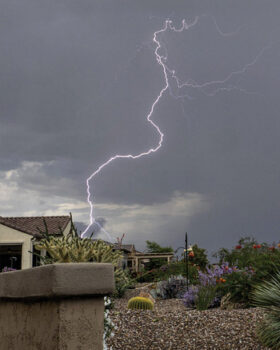
Flooded wash

Lightning
Sheilah Britton, Pinal County Master Gardener
The summer of 2021 has been a marvelous time for gardening in our SaddleBrooke/SaddleBrooke Ranch communities. Tomatoes, squash, potatoes, lettuces, herbs, and flowers were abundant before the rains of July—and cooler temperatures have allowed us to enjoy our home-grown delights for many days following the monsoon moisture.
This July was the wettest calendar month on record for Tucson, ever. More than eight inches of rain fell, according to the National Weather Service. SaddleBrooke received 6.46 inches (maps.cocorahs.org) and SaddleBrooke Ranch logged 7.67 inches, according to resident Tony Pietrzykoski’s weather station—all welcome relief for our gardens and landscapes. As we slouch toward September, there is much to be done to prepare for the cooler growing season.
As Texas rangers lose their purple majesty and bougainvillea blossoms fade, September is the perfect time to choose your annuals for the next bloom, so your yard will once again shine with color. Bulbs should be available by the end of the month, so start designing your flower beds ahead of time. You can begin to switch out your summer annuals for cool-season annuals as the temperatures cool down. Sow seeds for golden Dyssodia, Mexican gold poppy, lupine, desert bluebell, and cherry red sage for a range of color.
We now begin that transition from summer into fall, allowing us time to maintain and prepare our landscapes for cool weather, planting, and grooming our trees. Local growers and nurseries should have trees by the end of the month. As you amend your soil, consider planting native and/or drought tolerant trees and shrubs. Ironwood, mesquite, Texas ebony and acacia trees adapt well to our desert climate. Planting them this month will allow ample time to develop a solid root system before any danger of frost.
Now is a good time to consider adding shrubs to your landscape, as well. Look for plants that are not cold sensitive and plant early in the fall so they can establish a root system. Adding a generous layer of mulch to new shrubs will protect and encourage new growth. Some lovely desert shrubs include turpentine bush, San Marcus hibiscus, chuparosa, and desert lavender. As for pruning established shrubs, dead-head summer flowers and prune conservatively to discourage new growth.
Would you like to become a master gardener? If you’re reading this column, you likely have an interest in your landscape and gardens and you’ve probably discovered that gardening in our communities offers different challenges and rewards than gardening anywhere else.
The University of Arizona Cooperative Extension trains gardening enthusiasts of Pinal County as master gardener volunteers who help their fellow citizens grow better gardens and more sustainable landscapes. Our next training session for master gardeners’ certification begins soon.
* Class Dates: Oct. 6 to Feb. 16, 2022—Wednesdays 9 a.m. until noon
Tuition: $150 per individual and $225 per couple, which includes books and materials. Payment in full and a completed application is due by Sept. 27.
Course location: Anywhere with a computer and an internet connection
Certification as master gardener: Following successful completion of the training program, you will be required to log 50 hours of volunteer service within one year. A wide variety of volunteer opportunities are made available, as well as mentorships and training to assist you in reaching your goals.
For more information, contact Laurie Foster at lauriefoster123@yahoo.com.
SaddleBrooke/SaddleBrooke Ranch Master Gardeners are volunteers trained under the auspices of the University of Arizona, Cooperative Extension, Pinal County. We offer educational programs and classes to residents of our communities.
Need advice or have questions about your own garden? Send an email to planthelp@arizona.edu—include your name, address, phone number, and photos of your issues.
Please visit www.extension.arizona.edu/saddlebrooke-master-gardeners for more information.
